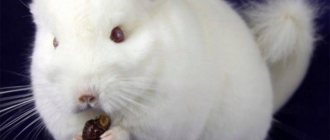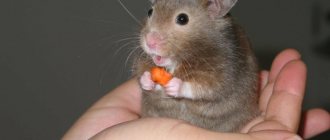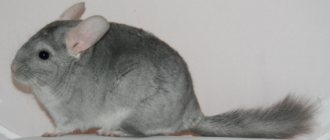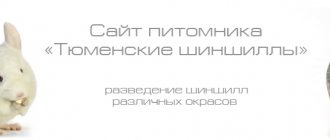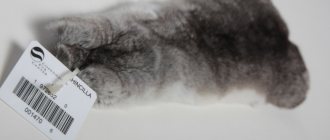Many believe that chinchilla breeds are fiction, and that the animals can be exclusively gray, the way they are most often seen in pet store windows and in photos on the Internet. However, this opinion is wrong. Breeders have been working for decades to ensure that the breeds and shades of these funny rodents only increase.
Below we will introduce you to the varieties of chinchilla colors and their breeds offered in nurseries.
Chinchilla breeds
These domesticated rodents are divided into two varieties, which have their own characteristics in the structure of the body and the length of the tail:
- Large short-tailed Peruvian chinchillas came to us from Bolivia and Argentina. These places are their homeland, and there they live in the wild, but only in protected areas, since local residents exterminate them for their valuable fur. In addition to nature reserves, they are also grown on specialized farms. Short-tailed chinchillas not only have dense fluffy fur, but also a fairly strong body. Standing on its hind legs, the animal reaches a height of up to 40 centimeters and weighs about 800 grams. The tail of large rodents is short, covered with stiff, short hair.
- Coast long-tailed chinchillas are common in Chile. They have a small body and a long tail covered with dense fur. Their weight does not exceed 700 grams.
Both chinchilla breeds are light gray in color. However, thanks to the efforts of breeders, long-tailed chinchilla rodents can now boast a huge variety of shades of their magnificent skin.
Angora chinchilla
One of the subspecies of long-tailed animals is the Angora royal chinchilla. It was not bred artificially. The rodent appeared thanks to the efforts of nature itself.
The animal was first noticed in the sixties of the last century. But he was included in the breed directory only in 2001. It is extremely difficult to breed this subspecies in artificial conditions, since the children from the male and female of this breed of chinchillas do not always turn out to have long hair; they often have short hair. It is for this reason that breeding Angora dogs requires the breeder not only to be professional, but also to carefully select pairs.
Angoras have silky long fur and a luxurious tail. In addition, they have long hair on their heads and paws. This breed of chinchilla has a flattened muzzle, which is why people call them Persian. The animals themselves are black, blue, diamond and purple.
“Angora chinchillas are the most expensive of all. The price of one individual is over 50 thousand rubles. The domestic animal has such valuable fur that the high cost of rodents has remained so for decades.”
Dwarf chinchilla
Mini chinchillas are also a natural genetic mutation. These animals have a small body, short legs and a bushy tail. The weight of rodents does not exceed 300 grams.
Dwarf domestic chinchillas give birth to the same cubs as their ordinary counterparts, so childbirth is difficult to endure. In most cases, babies do not survive. The animal must be under the supervision of a veterinarian throughout pregnancy. The shades of these cute animals can be different.
Causes of unpleasant odor
A foul odor can appear for two reasons:
- improper care of your pet;
- problems with his health.
In order for the animal to please others and not cause them discomfort, you need to understand in detail possible mistakes in order to avoid unpleasant consequences.
Important! A chinchilla should absolutely not be allowed to roam around the apartment unattended. The animal is very inquisitive and gnaws on everything that gets in its way, so a walk can end in poisoning, electric shock, suffocation, etc.
P.
Conditions of detention
There are a number of reasons that can lead to various diseases in an animal. The cheerfulness of a pet depends on how well the conditions for its life in your apartment are created.
The main factors influencing the health and mood of a chinchilla are:
Room air temperature. The most suitable temperature is +18…+20°C. Temperatures below or above normal negatively affect the health and activity of the chinchilla. Fluffy becomes lethargic and drowsy and refuses to eat. The temperature of +26°C is critical for the animal, causing heatstroke with a fatal outcome. Drafts. In the room with the cage there should always be a flow of fresh air, but without drafts that can cause colds in the animal. Air humidity. It is required to create humidity in the range of 50–60%. Chinchillas do not feel comfortable in rooms with high humidity. Direct sunlight. Placing the cage on the sunny side can lead to various diseases. Loud and sharp sounds. Chinchillas are very shy, so you should avoid shouting, loud music, etc.
etc., careless behavior can lead to stress and illness in the animal. Correctly selected cell. The size of the display case must be at least 70 cm high and 50 cm wide
The cage should be equipped with a drinking bowl, feeding trough, hay box and litter tray, as well as a lot of various shelves for entertainment. And if you also install a running wheel and a hammock, then your chinchilla will be infinitely happy. Nutrition. In addition to food and hay, which form the basis of the diet, rodents should receive plenty of twigs and salt wheels for grinding down their teeth. Chinchillas also love other healthy treats: dried apples, rose hips, hawthorn. Toilet filler. You can use sawdust, wood pellets, or buy regular cat litter. Many people mistakenly believe that hay is a suitable material for a tray. Hay is good for nutrition, but once it is collected in the cage as bedding, it must be removed before it becomes moldy or begins to rot.
Did you know? The chinchilla's skeleton has the ability to compress vertically, so they can penetrate the narrowest cracks and holes.
Animal diseases and health problems
Insufficient care is not the only reason for the foul odor emitted by the pet. Sometimes, despite the ideal cleanliness of the cage and tray, an unpleasant odor appears. It’s worth sounding the alarm if the animal itself smells. Very often, the cause of this kind of trouble can be health problems with the chinchilla.
If the animal smells bad, these could be the following possible ailments:
- Chronic diarrhea.
- Intestinal infection.
- Diseases of the urinary system.
- Complications after childbirth.
- Dental diseases.
The appearance of an unpleasant odor may be a consequence of the animal’s negative emotional state. A chinchilla can become stressed for several reasons. These include:
- severe fear;
- fight among teenage rodents;
- female refusal;
- prohibition of free movement outside the cage.
Varieties of colors
Since chinchillas have a lot of enemies in the wild, for their own safety, rodents have a light gray color, inconspicuous among rocky terrain.
Gray is the standard color for these cute animals, but artificially bred chinchilla breeds come in a wide variety of shades. Among them there are black, beige, white and even blue tones of chinchilla fur. Therefore, it is now extremely difficult to imagine that chinchillas originally had only gray colors.
All shades of chinchilla fur can be grouped as follows:
- gray or agouti: two shades that are standard;
- white, having different saturation and an admixture of beige and pinkish;
- brown or pastel, available in a full range of colors up to dark chocolate;
- black with varying degrees of saturation;
- purple, pink and sapphire.
In addition, it should be taken into account that fur colors differ not only in color, but also in:
- recessive. When a chinchilla is only a carrier of the gene responsible for the shade of its coat.
- dominant. When the color is already there and visible from birth.
When breeding rodents, it is extremely important to know what recessive color the male chinchilla and the female selected for mating have.
Character traits
By nature, Scottish chinchillas are aristocrats. Without contradicting their own principles, they do not stoop to conflicts with other pets living in the house. Quite sociable and peaceful, cats prefer to get along with everyone, including dogs. However, if the need for protection arises, these cats will be able to fend for themselves without unnecessary help.
Scottish chinchillas prefer not to show their affection. They do not allow themselves to be intrusive, have a reserved character, and do not like excessive squeezing. To some, these pets may seem phlegmatic, but, despite their apparent indifference, they rarely refuse the opportunity to play with both the owner and his children.
They are moderately patient, they can wait for their owner and miss him in his absence. When bored, pets can follow their owner, waiting for their portion of attention.
Chinchillas of this type are characterized not only by their royal appearance, but also by their extraordinary intelligence. They very quickly understand the rules established in the house and adapt to everything, including the lifestyle of their owners. Being inquisitive by nature, they often sit on the windowsill, looking at what is happening on the street. If they have their own toys, they will always find something to occupy their time in the absence of household members.
Rodents with gray color
Gray standard
Gray chinchillas are found both in the wild and in captivity.
Breeders divide them according to the color itself and its depth. Gray chinchillas are:
- light gray;
- medium gray;
- dark;
- moderately dark;
- extra dark.
Gray coloring is standard for chinchillas living in the wild and in domestic environments. The back of rodents is dark, the sides are light, and the belly is white. The wool has two shades. It is gray-blue at the base and black at the ends of the hairs.
Individuals of gray shades, unlike other rodents, are distinguished by very good health. In addition, the age of chinchillas of this shade to bear their first offspring is much lower than that of other subspecies. They can be crossed with absolutely any variety. Rodents have fur that is delicate and soft to the touch.
Light gray
Light gray fur with a silver tint looks very impressive. These chinchillas have a light chest, belly and limbs.
Medium gray
The most common color. The body of the animals has a uniform gray tint, the fur on the stomach, limbs and chest is light.
Dark
The fur has a gray tint with a bluish tint. The belly and chest of rodents are light, standing out well against the background of the rest of the fur.
Moderately dark
The fur of rodents has a dark gray tint, turning into ashy on the face, limbs and sides. Chinchillas have a bluish-white belly.
Extra dark
Many breeders prefer charcoal gray chinchillas with light sides and chest. The belly of this subspecies of rodents is almost white.
Rules of care
When you decide to get a chinchilla, you must take into account that the room in which it will live must meet certain requirements, first of all, it must be warm, light and dry, and the animal also needs good ventilation.
Care and maintenance of chinchillas requires the presence of fresh air, absence of drafts and humidity of 50-70%.
The most suitable temperature for chinchilla health is 18-20°C.
Also, to keep this cute animal you will need a special chinchilla cage.
The cage should be equipped with wooden shelves for the animals to rest. The width of the shelves should be 15 cm.
If desired, the cage can be equipped with ladders and tunnels. The cage must have a house in which the animals can rest and have offspring. The bedding in the house needs to be constantly changed.
The house should have the following dimensions: length 30 cm, depth 15 cm, height 15 cm, the house should be twilight.
A ceramic or iron feeder and drinker are attached to the wall of the cage or mounted on the door.
Chinchillas with light colored fur
Chinchillas with a white coat simply look luxurious and elegant. They have a number of unusual shades.
White Wilson
Chinchillas have white fur mixed with white or beige. You can purchase such an animal at a nursery or from breeders at home. The color is in demand among connoisseurs of these rodents.
Albino
These chinchillas do not have color pigments at the genetic level, so they have a snow-white tint and a red iris.
White lova
Chinchillas have white fur with a slight cream tint and dark ruby eyes.
White velvet
These animals have light fur that is velvety to the touch. Boy chinchillas often have a silver tint, while girls have a beige tint. In addition, they have distinctive gray spots on the head and limbs.
White-pink
The description of these chinchillas is as follows. Animals with milky white fur, pinkish ears and beady black eyes. However, there are representatives of this species that have a pink stripe on the back.
Origin story
The homeland of the chinchilla is considered to be the USA, where in 1880 an ordinary cat with a smoky color gave birth to a kitten with amazing silver fur, playing with tints from light to dark.
Experts were so amazed by this shade of fur that they deliberately began breeding cats with the same color. Today, chinchillas are found in the British and Persian breeds.
Although the formation of this type of cat took place at the end of the 19th century, the standard was approved only in the 80s of the 20th century, almost 100 years later.
As a result of breeding work, cats' eyes acquired a bluish-green and emerald color. The Persian chinchilla was originally bred to have a surprisingly long and smooth coat.
In the late 70s of the last century, this variety began to be added to the British and Burmese breeds.
Animals with beige fur
The main shade of these rodents is pastel. However, it has several variations. Additionally, the older the chinchilla, the darker its fur will be. It can be brown, red or beige. This type of rodent can be crossed.
Homobeige
This species of rodent has light beige fur with uniform coloring and pink ears. For this shade, single dark hairs are acceptable.
Heterobeige
In these rodents, on the contrary, the color is uneven. The entire coat is beige, and the undercoat and ends of the hairs are brown. When choosing a chinchilla, you should pay attention to the color distinction between the rest of the body and the belly.
Beige tower
The color of the fur of these animals varies from light to dark beige, which is combined with a brown pattern located along the spine.
Wellman beige
The chinchilla has light beige fur, light ears and dark eyes.
Beige Sullivan
Rodents have rich beige fur and red eyes.
Brown velvet
The basic fur color of these animals is beige, while the back and head have a chocolate tint, and the belly is sandy.
Appearance
Each cat breed has characteristics specific to that species. In the case of chinchillas, experts still cannot determine the standard criteria to give accurate definitions of weight, height and other characteristics.
From a distance, the animal's fur appears to be a uniform golden tone, but this is deceiving. Each hair has a double color, at the root it is pure red, the tips are black. The color smoothly transitions into one another, which gives a slight shadedness, which is especially pronounced on the sides and on the back.
You can determine the golden color of a fur coat by the following parameters:
- the basal part of the guard hair and the undercoat are peach-colored;
- the middle part of the guard hair is black;
- upper part – shaded color;
- the tip of the hair is tipped;
- the tip of the tail is the base color.
The Scottish Golden Chinchilla has a medium-length, bouncy, plush-like coat.
Nibelung
Maine Coon
Cat Likoi
Signs of a Scottish Golden Chinchilla:
- the head is round, small, with a protruding skull, pronounced chin, thick cheeks;
- forehead - with a small flat depression;
- ears – folded, tilted down and forward (Scottish fold) or straight, medium in size (Scottish Straight);
- nose – short, upturned, pale pink, with a dark outline;
- eyes – large, expressive, widely set, emerald in color, with dark edging;
- body – compact, with developed muscles, straight back, chest – raised;
- paws - the same size, rounded, with dark pads and hair between the toes;
- the tail is straight, short, thick, drooping, with a rounded tip.
The weight of an adult reaches 6-8 kg, life expectancy is 12-15 years.
Chinchilla ebony
These animals are distinguished not by a certain color, but by the quality of their skin. If you bring the rodent to the light, the fur begins to shine and shimmer. The color palette of such chinchillas is quite diverse.
Homoebony
Chinchillas of this color have black fur and black eyes. Also, the color of these animals has a second name - charcoal.
Heteroebony
These rodents combine two shades: black and gray. They are very impressive and often take first place at exhibitions.
White ebony
Chinchillas have snow-white fur with a black coating at the ends of the hairs. The limbs, head and base of the tail may have a beige tint.
Character traits
Chinchilla cats can be called noble aristocrats. They have a soft, easygoing character, become attached to their owner and get along with children - they tolerate it even if they pull their tails. But if possible, they try to retreat from the nursery as quickly as possible. Left alone, the animal will prefer special toys rather than the owner's furniture.
As already mentioned, cats are human-oriented, and therefore require increased attention to their person. Their favorite place is on their owner's lap. Loneliness is contraindicated for representatives of this breed - they experience stress, feel sad, and may even get sick. At the same time, chinchillas are self-sufficient and do not like it when their personal space is invaded. If the cat does not want to be touched or stroked at the moment, she will make this clear.
As kittens, animals can spend hours playing, running after toys or rustling candy wrappers. However, as cats grow older, they play less and less, as if to demonstrate that they are representatives of the royal breed. An adult cat will prefer bliss in some warm and soft place to games.
At the same time, it is still important to play with your pet, since a sedentary lifestyle is a direct path to obesity and disease.
Representatives of the breed are distinguished by their delicate character and intelligence. Cats are clean and easy to train. The owners also note that chinchillas are big fans of “talking.” They respond to affection with numerous purrs; they can meow to their owner when they are bored or something is bothering them. The usual “meow” and “mur” have many intonations in their “lexicon”.
Chinchillas with dark fur
These rodents include black velvet chinchillas with rich black fur and a white belly.
Black velvet
This color combines black and white. The animals have a black body and tail, and a white belly. This contrast looks very impressive and the clearer the color boundaries, the higher the price of a chinchilla and the more valued the breed is.
This species of rodent was bred in the 60s of the last century. Breeders believe that the dark skin is evidence of the high quality of the breed. Chinchillas may have light stripes on their limbs, a charcoal mask, and dark fur on their heads.
The older a rodent gets, the more pronounced its breed characteristics become. Since the black fur gene is lethal, crossing with representatives of your own breed is unacceptable; black chinchillas can only be mated with rodents of other colors.
Nutrition
The chinchilla is a herbivore and therefore you will need to stock up at home:
- oats,
- corn,
- sunflower,
- barley,
- wheat,
- oatmeal
- hay,
- peas,
- chalk,
- herbal flour.
All cereals are usually mixed and placed on a plate in a cage. And of course a bottle of water.
The chinchilla eats very little. During the day, an adult animal eats:
- about 30 gr. feed (total 2 tbsp.),
- Hay 1-2 times a week.
So for a year a chinchilla needs 12 kg of feed and 6 kg of hay.
Rare colors of chinchillas
The most expensive and valuable animals have a rare, very beautiful color. Breeders managed to breed several breeds, looking at which it is simply impossible to contain delight.
Violet
Rodents have a light lilac coat, contrasting with a white belly. The ears and nose of the animals have a purple tint. When crossed, the unusual color is passed on only in the first and second generations. Purple chinchillas mature late and can mate only after one and a half years.
Sapphire
The fur of these animals can be either bluish-gray or light blue with a light graphite coating. Chinchillas have a white belly and black eyes. The animals are among the most expensive and sought after among breeders. The unique coloring does not appear immediately, but only by 8 months. To purchase a real sapphire chinchilla, it is better to purchase the rodent from a licensed nursery.
Blue Diamond
Chinchillas have light blue fur with a metallic sheen. There is a dark stripe along the ridge and head.
White and pink diamond
One of the rare colors is pearl with a pinkish tint. The color of such chinchillas' fur resembles pearls. The exception is the ears, which have a pinkish tint. The pearl gene is lethal, so representatives of the same breed cannot be crossed. Chinchillas of other colors are suitable for mating.
Crossbreeding
When choosing a pair for Wilson White, take into account the fact that these animals carry the “lethal gene”. That is, when crossing two white rodents, there is a risk of the birth of dead offspring or weakened individuals whose lifespan does not exceed 4-5 months. There are no restrictions on crossbreeding with other colors; the gene will be dominant in all cases. The most common pairings for Wilson White are:
- Black Velvet - you will get offspring with the following colors: Standard, Black and White Velvet, Wilson White;
- Beige - children can be: Standard, Beige, White, White-pink;
- Brown velvet - this option gives the largest number of possible colors: Standard, White, Beige, White-pink, as well as velvet variations of the main colors;
- Homobeige - offspring can have a Beige or White-pink color.
One of the most beautiful varieties of Wilson's offspring is the White and Pink or Apricot. Such rodents have three genes - white, beige and standard, which makes them interesting for breeders. The color of the animals' fur can be either snow-white or with gray or chocolate tan markings, different in type and location. Apricot is not recommended to be crossed with individuals that have the white gene.
Breeding chinchillas
Thanks to the wide variety of rodent colors, breeders have plenty of opportunities to develop new breeds. Crossbreeding itself is a unique process, because you never know whether the babies may display a recessive gene from one of the parents. However, there are also restrictions on mating individuals. For example, there are two lethal genes: black and white. They cannot be combined, otherwise not only the babies, but also the female herself may die while carrying them.
"Note! To carry out successful crossbreeding, all breeders have passports for their animals. The documents indicate what genes their pets have, and also indicate the possible color of their future babies.”
How location of purchase affects cost
Market
The cost of animals on the poultry market is much lower. When choosing this method of acquisition, you should take into account the presence of a large number of risks, since this source is not reliable.
The main market assortment is culled individuals (sick, small and having other defects). Too low a price (up to 2,000 rubles) should alert the buyer - the animal will probably not live longer than a couple of months.
In markets in regions where there are no breeders, the cost of chinchillas is higher. But this is not a guarantee of quality, but only a consequence of the lack of competition.
Results
Breeding chinchillas is a very profitable business. However, in order to become an experienced breeder, you should take into account not only the breeds of chinchillas and their colors, but also know all the intricacies of the care and nutrition of these magnificent animals.
Gray and beige rodents are easier to breed, they are more common, and their babies are cheaper than, for example, sapphire and purple ones. Crossing and breeding chinchillas is an extremely complex process, so it needs to be approached wisely and only done by those people who are truly interested in it. You should not do this for the sake of banal profit, since nothing good will come from such a business.
Not only breeders, but also scientists around the world are engaged in breeding new breeds. They are driven to this by the popularity of rodents not only as pets, but also by their breeding as specimens to obtain valuable fur.
Keeping a chinchilla at home is not very easy, but it is worth it. The animals love their owners very much and treat them with tenderness and love. Breeders advise purchasing chinchillas in pairs, because there is nothing more pleasant than watching their games, affection, love and friendship, which a person can only envy.
Theme: Heteroebony
Quick transition Basic colors, one gene Up
- Navigation
- Cabinet
- Private messages
- Subscriptions
- Who's on the site
- Search the forum
- Forum home page
- Forum
- All about chinchillas, general questions
- Who are Chinchillas? Newbie questions
- Care and maintenance at home
- Cages, display cases and their arrangement
- Food and treats, all about feeding and nutrition
- Features of behavior, observations
- Congratulations on your newborn!
- Breeding chinchillas - mating, pregnancy, childbirth
- Finally born! Photos of little chinchillas
- Bad feeling. Diseases and treatment
- Diseases, Treatment of chinchillas
- Veterinarians, veterinary clinics and pharmacies
- Colors and genetics
- Colors and genetics, general questions
- Basic colors, one gene
- Simple colors, two genes
- Complex colors, more than 2 genes
- About pleasant things
- I'm happy - I have a new pet, chinchillomania is progressing!
- We are such beautiful chinchillas!
- SALE OF CHINCHILLAS AND RELATED PRODUCTS (paid section)
- Rules for using this section. Read for everyone.
- Food and products for chinchillas from CHINCHILLA WORLD
- Chinchillas for sale from a breeder in Moscow Chinchillas aged 0 to 2 years
- Chinchillas aged from 2 years to 5 years
- Chinchillas aged 6 to 8 years
- Chinchillas aged 8 years and older
- Chinchillas are not for breeding, as pets
- Chinchillas for sale from a breeder in St. Petersburg
- Chinchillas aged 0 to 2 years
- Chinchillas aged from 2 years to 5 years
- Chinchillas aged 6 to 8 years
- Chinchillas aged 8 years and older
- Chinchillas are not for breeding, as pets
- Sale of chinchillas from a breeder in Russia (except Moscow and St. Petersburg)
- Chinchillas aged 0 to 2 years
- Chinchillas aged from 2 years to 5 years
- Chinchillas aged 6 to 8 years
- Chinchillas aged 8 years and older
- Chinchillas are not for breeding, as pets
- Sale of chinchillas from a breeder in Ukraine
- Chinchillas aged 0 to 2 years
- Chinchillas aged from 2 years to 5 years
- Chinchillas aged 6 to 8 years
- Chinchillas aged 8 years and older
- Chinchillas are not for breeding, as pets
- Selling chinchillas from a breeder in other countries
- Chinchillas aged 0 to 2 years
- Chinchillas aged from 2 years to 5 years
- Chinchillas aged 6 to 8 years
- Chinchillas aged 8 years and older
- Chinchillas are not for breeding, as pets
- Selling non-own breeding chinchillas
- Selling chinchillas from forum newcomers
- Products for chinchillas
- Cages, display cases from manufacturers and pet stores Moscow
- Saint Petersburg
- Other cities in Russia
- Ukraine
- Other countries
- Accessories for chinchillas from manufacturers and pet stores
- Moscow
- Saint Petersburg
- Other cities in Russia
- Ukraine
- Other countries
- Food, additives, treats
- Moscow
- Saint Petersburg
- Other cities in Russia
- Ukraine
- Other countries
- REQUESTS FOR PURCHASE, EXCHANGE, GIVEAWAY, etc.
- I will buy a chinchilla, purchase requests
- I'll give away a chinchilla, Exchange, Joint couples
- Delivery from beyond Bug.
- BIRD MARKET (free chinchilla sales section)
- Sale of chinchillas in Moscow and Moscow Region
- Sale of chinchillas in St. Petersburg and Leningrad Region
- Sale of chinchillas in other cities of Russia
- Selling chinchillas in other countries
- OTHER SALES (not chinchillas)
- Sale of used goods
- Sales of other pets
- PEOPLE AND ANIMALS.
- World of Lemurs Lemurs, all about Lemurs
- Sale of lemurs
- Hedgehog World
- Keeping and breeding hedgehogs
- Varieties of hedgehog colors
- Nutrition and feeding of hedgehogs
- Sale of hedgehogs
- My home zoo, pets.
- Sugar glider
- Rabbits: decorative, dwarf
- Guinea pigs
- Rats
- Hamsters, mice, degus
- Dogs
- Cats, cats, kittens.
- Other favorites
- Exotic animals
- My hobbies
- Music
- Vacations, travel
- Food
- Movies
- Painting
- Needlework.
- Photo
- Flowers
- Sport
- Programs
- Design
- Fishing
- Literature
- Collecting, other hobbies
>Colors and breeds of chinchillas
Over the years, thanks to selective breeding, chinchillas have received many colors. Here we have collected the most common of them with photographs and descriptions.
Useful materials:
- Poodle haircut photo Rostov Types of haircuts A classic, discreet look or a bright and extraordinary haircut will allow you to create a unique style for your…
- Basset Hound photo and description Characteristics and standards The description of a Basset Hound dog must meet the following parameters: The height at the withers of the bitch reaches…
- House for chinchillas Types, shapes and types of houses for chinchillas What types of houses for chinchillas can be found: from…
- Black Scottish Fold photo Description of the breed The external resemblance to British cats is not accidental, because they are considered close relatives. But the differences...
Description of the animal
We should start with the fact that these animals belong to the category of rodents. The body is quite large - depending on the sex and breed, its length can range from 22 to 38 centimeters. In this case, the length of the tail reaches 15-17 centimeters. On a large, slightly elongated head with curious eyes there are rounded ears. Long vibrissae grow around the nose - sometimes they grow up to 10 centimeters. The front paws are five-toed, and the hind paws are four-toed. But the latter are twice as long, which allows chinchillas to make serious high jumps. Thin, flexible fingers allow you to grab food and also help you climb vertical surfaces.
The ears have special membranes that cover the ears and prevent foreign objects from entering during sand baths. Males are slightly smaller than females. On average, their weight is 700 grams, while that of females is 800 grams.
They are most active at night, when they go hunting. Large eyes, sensitive ears and long whiskers give them the ability to perfectly navigate in the dark.
In general, the animals are very beautiful, even elegant. It is no coincidence that even a breed of silver chinchilla cats has appeared, the owners of which have only positive reviews.
White Wilson
Story
It is believed that the name of this chinchilla breed was given in honor of Mrs. Wilson. According to some reports, it was on her ranch that these furry animals appeared. At first, the breeder thought the animal was an albino because of its white color. But when the White chinchilla gave birth, it became clear that this was a new type of color.
Color
This breed has different color variations. From snow-white to dark. Which color will depend on the crossing.
It is worth noting that no matter the shade of the coat, the ears and eyes remain unchanged. Other breeds of chinchillas usually have black eyes and ears. White Wilsons, on the other hand, are usually gray or dark gray. The beginning of the tail is surrounded by a dark ring. The belly and limbs are white. The main black of this species is the snow-white tip of the tail.
If there is a yellow color in the fur, this indicates a mixture of the breed and poor quality wool.
In the White Wilson chinchilla, the following types of color are most common:
The mosaic coloration is similar to that of Dalmatians. Her fur is covered with dark spots that have different shapes. This color is considered to be inherited. The value of such fur is determined by the symmetry of the dark spots and their saturation.
Platinum coloring is distinguished by a gray coating over the entire surface of the fur.
The silver color is highlighted by the color of the tips. The tips of this color are gray, which creates the illusion of a silvery coating.
The rarest is the tricolor. With this color, three colors can be seen on the animal’s fur: gray, white and black. Stripes and spots on the fur form a unique pattern. Chinchillas are generally bred for their fur and the profitability of the business. Therefore, this color has one of the highest prices on the market. Increases the cost of both the chinchilla itself and its fur.
Contents of the White Wilsons
This type of pet does not require special care. They only need:
- Spacious and equipped cage (house, running wheel, etc.);
- Bathing;
- Special diet.
Chinchillas prefer to move by jumping. Therefore, the cage must be high enough. It is desirable that it have a variety of shelves, ladders, and tunnels.
Genetic calculator
Chinchilla genetics is an interesting and rather complex science. A large combination of genes and their combinations, dominant and recessive manifestations can confuse even experienced breeders. Therefore, a special genetic calculator for chinchilla colors was developed. The main genes of the parents are entered into the calculator: white, beige, sapphire, ebony, purple, velvet and angora, as well as the degree of manifestation of the genes:
- Present or not,
- Double or not
- Carrier or not,
- Gene shade (from light to dark).
Based on the data obtained, the calculator calculates not only the genotype of the parent pair, but also all possible colors of the offspring and the probability of obtaining them. The calculator is useful not only for beginning breeders, but also for those who want to breed a new color morph or fix a specific gene. You can find a genetic calculator on numerous websites of chinchilla breeders and large nurseries.
Advantages and disadvantages
The breed was bred as a universal breed, so it is slightly inferior to the meat subspecies. But with good feeding, you can quickly fatten up heavy rabbits.
Advantages of the Soviet chinchilla:
- They quickly adapt to different weather and living conditions.
- High productivity in females.
- Due to their large size they produce a lot of meat.
- Fur is highly valued due to its high quality and unusual color. The density of the fur is twice as high as that of other breeds.
Flaws:
- Spacious cages are needed for maintenance.
- Requires a lot of grain and hay for feeding.
- The farm requires significant expenses.
